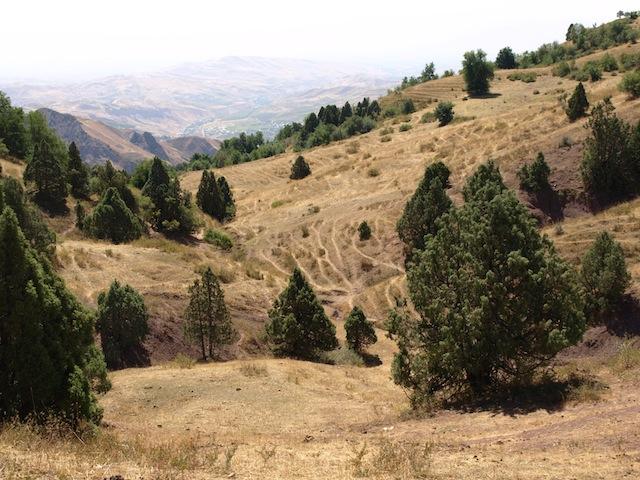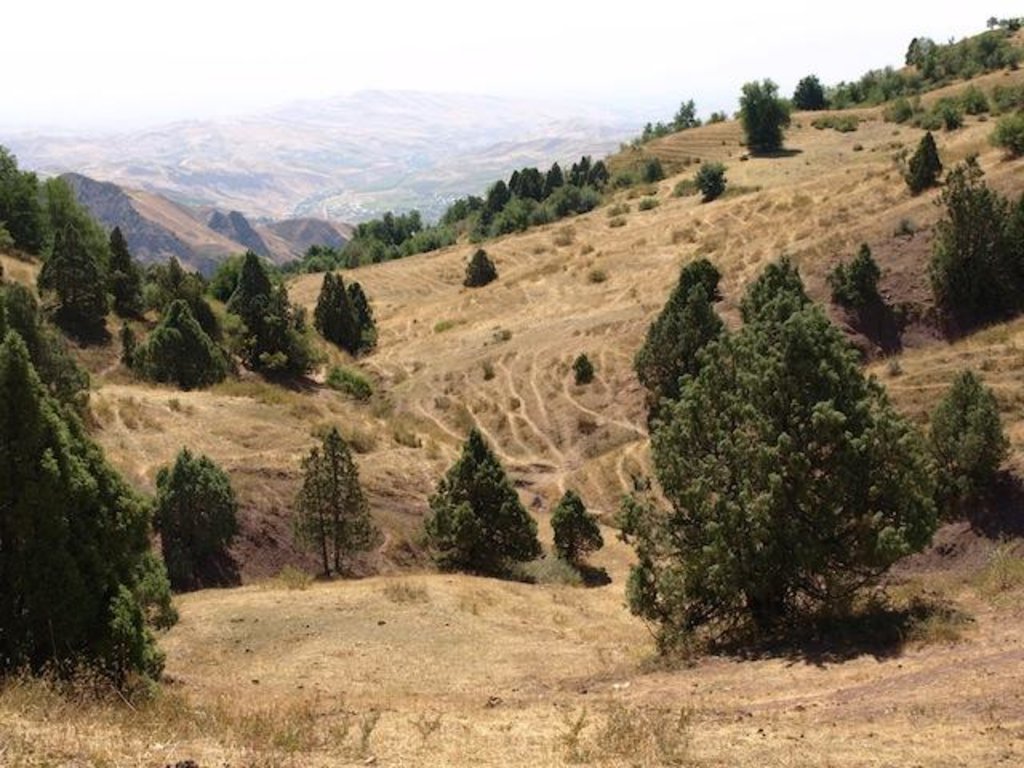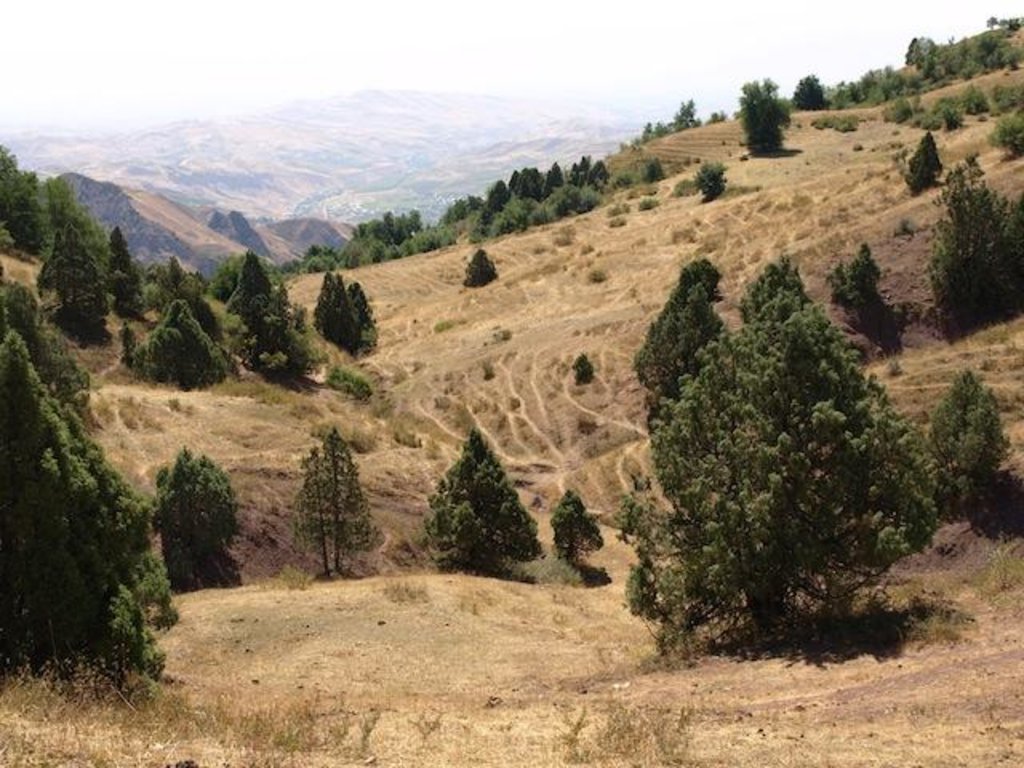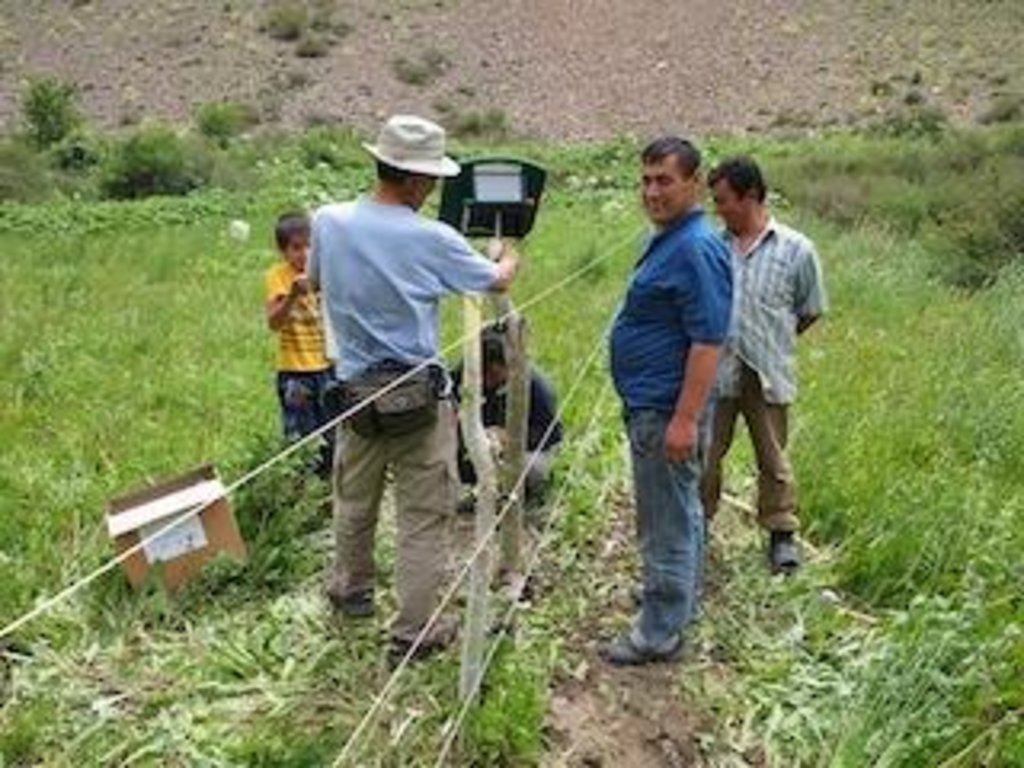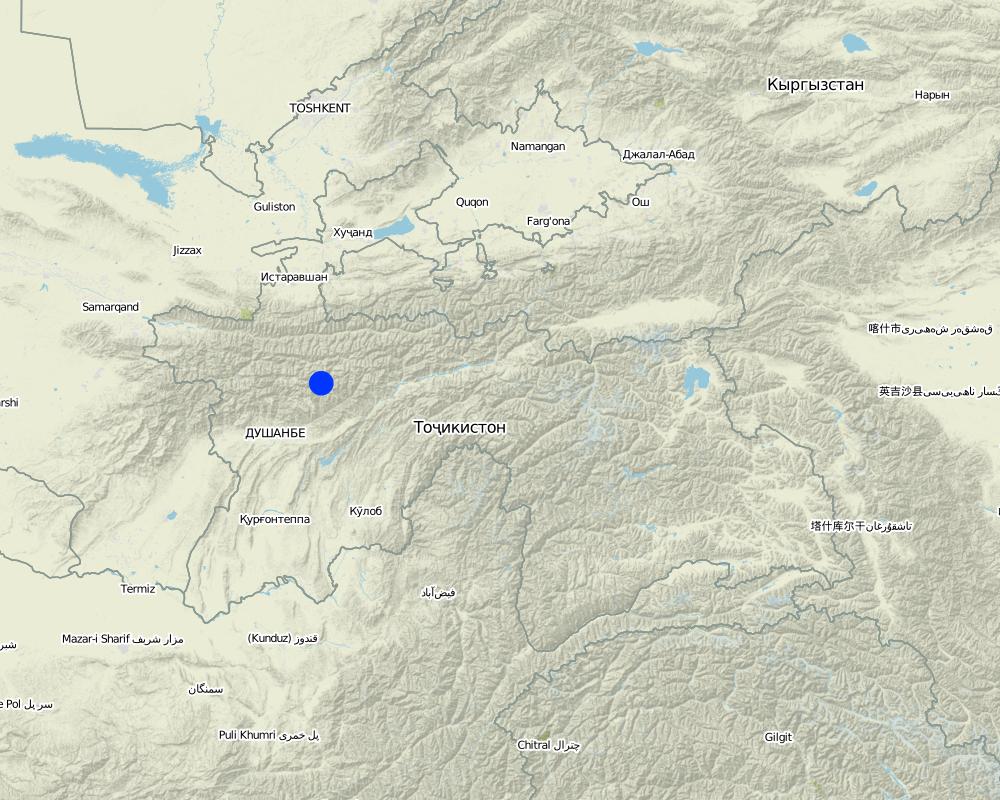Sustainable managements on pasture and forest lands based on natural regeneration by electrified fences [Tajikistan]
- Creation:
- Update:
- Compiler: Kakubari Yochitaka
- Editor: –
- Reviewer: David Streiff
approaches_2451 - Tajikistan
View sections
Expand all Collapse all1. General information
1.2 Contact details of resource persons and institutions involved in the assessment and documentation of the Approach
SLM specialist:
Aidov Madibron
SFA
Russian Federation
SLM specialist:
Kumalova Rina
FRI
Russian Federation
translator/assistant:
Shoh Sharipov
Russian Federation
Name of the institution(s) which facilitated the documentation/ evaluation of the Approach (if relevant)
Shizuoka University - Japan1.3 Conditions regarding the use of data documented through WOCAT
When were the data compiled (in the field)?
11/06/2011
The compiler and key resource person(s) accept the conditions regarding the use of data documented through WOCAT:
Ja
1.4 Reference(s) to Questionnaire(s) on SLM Technologies
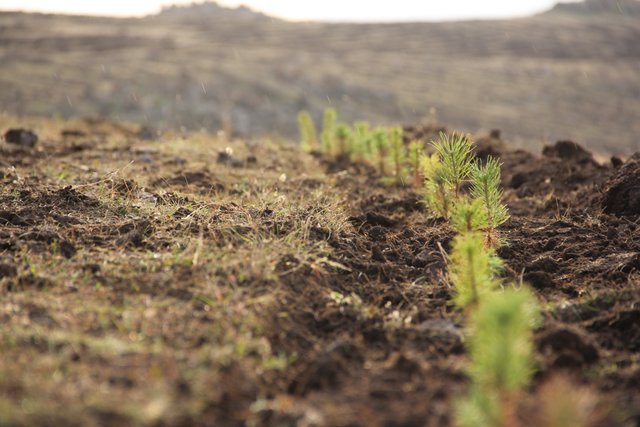
High-altitude afforestation for erosion control [Armenia]
Afforestation is a key technologies to protect soil against erosion and provide a wide range of ecosystem services. In this case, afforestation at high altitudes, which is particularly challenging, with the primary purpose of erosion control were planted in small patches with different methods. They form the basis for future …
- Compiler: Hanns Kirchmeir
2. Description of the SLM Approach
2.1 Short description of the Approach
Sustainable managements on pasture and forest lands based on natural regeneration by electrified fences
2.2 Detailed description of the Approach
Detailed description of the Approach:
Aims / objectives: The aim is to avoid any animals grazing in the targeted areas by establishing electrified fences around the areas, conserving natural conditions of pasture and forestry lands, strengthening the communities’ incomes growth, and planting trees resilient to climate change, thereby contributing to maintaining soil of the areas healthy.
Methods: The project facilitated the following activities: Setting electrified fences that are generated by solar power, strengthening the regeneration of natural forest tree, planting fruiting trees for their sustainable incomes, planting trees such as juniper, pine, poplar, willow, among others. Planting Rosa canina in side of fence and R.C. grown up 2 meter height a few years later and functions as a natural fence. Electrified fence is moved to other site. Also, the project was heavily involved with farmer participation for the planning, fundraising, and implementation with farmers’ initiative.
Stages of implementation: 1. Awareness raising, 2. On the job training, 3. management activity planning, 4. Implementation, 5. Monitoring, 6. Readjustment based on results, 7. Further replication in new area.
Role of stakeholders: The Project had a leading role in initiation, orientation, awareness raising, mobilization, training, consultancy, input provision and mediation of communication. The local farmers have been actively participating, have provided labor input / financial contribution, provided indigenous knowledge and skills. Local authorities - providing land titles, participation in planning and decision making process. There are 5 households involved with in this project. The two Tajik communities (Duoba in Hisor and Kumarg in Ayni), each of which is consisting of 35 members. The members of all households took part in discussion rounds and training. Women: farmers came to the discussions together with their wives in certain level; the women took part in training, in implementing almost all of the adoption measures, and equally benefited from the project. However, they were not involved in decision making.
2.3 Photos of the Approach
2.5 Country/ region/ locations where the Approach has been applied
Country:
Tajikistan
Region/ State/ Province:
Tajikistan
Further specification of location:
Hisor/ Ayni
Map
×2.6 Dates of initiation and termination of the Approach
Indicate year of initiation:
2009
Year of termination (if Approach is no longer applied):
2012
Comments:
We have performed to collect about various ecological disasters in Tajikistan since Sep.2009, and over 75 base line research sites are done by Japanese Society of Promotion for Science (JSPS). Japanese International Cooperation Agency (JICA) supported us. Research title is as follow; Reforestation and forestation in aim of reduction of generation of greenhouse gases and lessening of global warming
2.7 Type of Approach
- project/ programme based
2.8 Main aims/ objectives of the Approach
The Approach focused mainly on SLM with other activities (natural regeneration, pasture management, protecting fruits trees, strengthening community incomes, resilient to climate change )
The aim is to avoid any animals grazing in the targeted areas by establishing electrified fences around the areas, conserving natural conditions of pasture and forestry lands, strengthening the communities’ incomes growth, and planting trees resilient to climate change, thereby contributing to maintaining soil of the areas healthy.
The SLM Approach addressed the following problems: Lack of land tenure rights implementation. Nominal state farm reorganization. Low agricultural production - lands depleted of nutrients, very low yields, no crop rotation, all of which have led heavy concentration on overgrazing by domestic cattle. Soil degradation particularly by heavy precipitation and gully formation. Lack of technical knowledge and awareness of soil & water conservation measures. Lack of cash to invest in development of land - just limited capacity to invest but need external financial input. Poverty - underlying cause of general lack of potential to invest in development.
2.9 Conditions enabling or hindering implementation of the Technology/ Technologies applied under the Approach
availability/ access to financial resources and services
- hindering
Lack of land tenure rights implementation. Nominal state farm reorganization. Low agricultural production - lands depleted of nutrients, very low yields, no crop rotation, all of which have led heavy concentration on overgrazing by domestic cattle. Soil d
Treatment through the SLM Approach: 1) The project was mainly supported by Japan Society for Promotion of Science and Japan International Cooperation Agency with some portion of Tajik government’s sources. However, the inputs (poles and wires) are almost fully available on the local market
institutional setting
- hindering
1) The project was mainly supported by Japan Society for Promotion of Science and Japan International Cooperation Agency with some portion of Tajik government’s sources. However, the inputs (poles and wires) are almost fully available on the local market
Treatment through the SLM Approach: Knowledge and technologies are shared with S.F.A. in Dushanbe when necessary. By coordinating with S.F.A., the project obtained the right to use the land for planting. As well, local offices of State Forest Agency and local authorities and communities are
legal framework (land tenure, land and water use rights)
- enabling
The existing land ownership, land use rights / water rights helped a little the approach implementation: I think it is very serious relationship between Land user ship and local citizens. and forest code is not coming enter on current datum. I think it is very important to be managed by new forest code.
- hindering
Implementing the land tenure law and the privatization of state farms is still a difficult process with many inconsistencies for people claiming a land title in the area.
Treatment through the SLM Approach: AS shown above, by coordinating with State Forest Agency, the project was able to obtain land usage agreement on specific land plots.
3. Participation and roles of stakeholders involved
3.1 Stakeholders involved in the Approach and their roles
- local land users/ local communities
Men and women have both played an equal part in the orientation and planning sessions; men have played bigger role in the organization of activities, in the implementation of more manual work, whereas, women took part in the lighter work and in routine maintenance
- SLM specialists/ agricultural advisers
- teachers/ school children/ students
- NGO
- private sector
- local government
- national government (planners, decision-makers)
- international organization
3.2 Involvement of local land users/ local communities in the different phases of the Approach
| Involvement of local land users/ local communities | Specify who was involved and describe activities | |
|---|---|---|
| initiation/ motivation | external support | farmers meeting with the team for orientation explaining goals, objectives. The communities who had strong understanding and willingness have only been selected. |
| planning | interactive | on site planning with farmers |
| implementation | interactive | training on the job, material inputs, and labor provision, cross visits |
| monitoring/ evaluation | interactive | Visits from the team at least once a month since the beginning, communications on ongoing activities, finding solutions. |
| Research | self-mobilization | The team shares with the farmers the findings. |
3.3 Flow chart (if available)
Description:
Organization of the sustainable Land management for pasture and forest lands is described in organization chart. It will be divided with three parts; career training, Basic research and afforestation.
Author:
yoshitaka Kakubari (Univ. of Shizuoka, Japan)
3.4 Decision-making on the selection of SLM Technology/ Technologies
Specify who decided on the selection of the Technology/ Technologies to be implemented:
- mainly land users, supported by SLM specialists
Explain:
mainly by sustainable land management specialists from Shizuoka University, State Forest Agency, and Forestry Research Institute, with consultation of land users.
Decisions on the method of implementing the SLM Technology were made by mainly by land users supported by SLM specialists. mainly by sustainable land management specialists from Shizuoka University, State Forest Agency, and National Academy of Science, with consultation of land users.
4. Technical support, capacity building, and knowledge management
4.1 Capacity building/ training
Was training provided to land users/ other stakeholders?
Ja
Specify who was trained:
- land users
- field staff/ advisers
If relevant, specify gender, age, status, ethnicity, etc.
Training provided for local communities, local authorities, State Forest Agency
Form of training:
- on-the-job
- farmer-to-farmer
- demonstration areas
- public meetings
- courses
Subjects covered:
Training focused on how to plant trees and how to manage them, how to set up the fences, how to use the fences,
4.2 Advisory service
Do land users have access to an advisory service?
Ja
Specify whether advisory service is provided:
- on land users' fields
Describe/ comments:
Name of method used for advisory service: Prof.Dr.Yoshitaka Kakubari;
Key elements: consultation on fencing concepts and choice for preventing from overgrazing, capacity building in strategy design, draft development plan for fence managements; 4. Land use management design considering soil depth, inclination and exposure. 5. Consultation on irrigation design, piping and making water channels 6. Consulting dry farming for good trapping of surface runoff and terrace planting method. 7. Treatment of tree saplings and transportation to the field. 8. Treatment of tree sapling on nursery, light and water regulation. 9. Grand treatment and cleaning, transportation of fertilization 10. Consultation on Planting, and judgment of leaf
Advisory service is totally inadequate to ensure the continuation of land conservation activities; The extension system is inadequate to ensure continuation of activities. The government branches need more development and organization to become able to manage land conservation activities; an independent advisory service is not in place, the only potential still exists within the DWHH Project
4.3 Institution strengthening (organizational development)
Have institutions been established or strengthened through the Approach?
- yes, a little
Specify the level(s) at which institutions have been strengthened or established:
- local
- advising to make a land use managements
4.4 Monitoring and evaluation
Is monitoring and evaluation part of the Approach?
Ja
Comments:
bio-physical aspects were regular monitored by other through observations; indicators: Frequent visits and observations by the project team - tree planting, growing situation, regeneratio
bio-physical aspects were regular monitored by None through measurements; indicators: Ad hoc observations by the project team - labor availability, etc.
technical aspects were ad hoc monitored by None through observations; indicators: Regular measurements by the project team- fodder produced cent/ha, vegetables
socio-cultural aspects were regular monitored by None through observations; indicators: Ad hoc observations by land users and frequent visits by the project team
economic / production aspects were ad hoc monitored by None through measurements; indicators: Ad hoc observations by land users and frequent visits by the project team - technology adaptation ba
area treated aspects were None monitored by None through observations; indicators: None
management of Approach aspects were None monitored by None through observations; indicators: None
There were no changes in the Approach as a result of monitoring and evaluation: There were no changes in the approach. However, the trees planted by the local communities after technical advice and demonstration was not appropriately planned, therefore, after the monitoring and evaluation, they were re-planted. Also, the project team realized that it would be better to have plant relatively young trees as they adapt better in the targeted areas.
There were few changes in the Technology as a result of monitoring and evaluation: I'm able to confirm them after and after they can treat tools and planting materials before they have done. It was very roughly to treat root system of planting saplings, therefore material becomes very weak and easy to die.
4.5 Research
Was research part of the Approach?
Ja
Specify topics:
- ecology
Give further details and indicate who did the research:
It focuses on observation of the trees and other plants in the fenced areas, especially regeneration of originally seeded plants. Tree growth rates and damages of grazing are recorded inside and outside of fencing area. For getting evidence by electric fences, we will try a small experiment. We shall confirm that electric fence protects plants from grazing of domestic animals.
Research was carried out both on station and on-farm
5. Financing and external material support
5.1 Annual budget for the SLM component of the Approach
If precise annual budget is not known, indicate range:
- 10,000-100,000
Comments (e.g. main sources of funding/ major donors):
Approach costs were met by the following donors: international (Japanese Society Promotion of Sciences (JSPS) and JICA): 100.0%
5.2 Financial/ material support provided to land users
Did land users receive financial/ material support for implementing the Technology/ Technologies?
Nee
5.3 Subsidies for specific inputs (including labour)
- equipment
| Specify which inputs were subsidised | To which extent | Specify subsidies |
|---|---|---|
| tools | fully financed | Shovel, hoe, pipe, iron wire etc |
- agricultural
| Specify which inputs were subsidised | To which extent | Specify subsidies |
|---|---|---|
| planting materials | fully financed | |
- construction
| Specify which inputs were subsidised | To which extent | Specify subsidies |
|---|---|---|
| wood | fully financed | fences, wooden pole |
- infrastructure
| Specify which inputs were subsidised | To which extent | Specify subsidies |
|---|---|---|
| irrigation system | fully financed | |
- other
| Other (specify) | To which extent | Specify subsidies |
|---|---|---|
| material transportation | fully financed |
If labour by land users was a substantial input, was it:
- paid in cash
Comments:
It is important to pay to land users and regional villagers.
Also labour is paid in food-for-work
5.4 Credit
Was credit provided under the Approach for SLM activities?
Nee
6. Impact analysis and concluding statements
6.1 Impacts of the Approach
Did the Approach help land users to implement and maintain SLM Technologies?
- No
- Yes, little
- Yes, moderately
- Yes, greatly
We have oft said to local villagers how to take a treatment and transportation of materials to pilot site, and how to make a water irrigation channels etc.
Did the Approach empower socially and economically disadvantaged groups?
- No
- Yes, little
- Yes, moderately
- Yes, greatly
Yes, it is still not obvious.
Did the Approach improve issues of land tenure/ user rights that hindered implementation of SLM Technologies?
- No
- Yes, little
- Yes, moderately
- Yes, greatly
I have already described in above the paragraph about the reason.
Did other land users / projects adopt the Approach?
- No
- Yes, little
- Yes, moderately
- Yes, greatly
We make a two pilot sites, Duoba in Hisor and 2 sites Kumarg sites in Ayni districts for implementations to other citizens, and welcome to many guests from other district and sometimes taking many visitors from Governmental organizations.
Did the Approach lead to improved livelihoods / human well-being?
- No
- Yes, little
- Yes, moderately
- Yes, greatly
It is not still positive changes of local citizens but I believe changing positive in future.
Did the Approach help to alleviate poverty?
- No
- Yes, little
- Yes, moderately
- Yes, greatly
I have not still any evident for explanations.
6.2 Main motivation of land users to implement SLM
- increased production
introducing to fruits trees at first , and after introducing forest trees
- increased profit(ability), improved cost-benefit-ratio
ntroducing to fruits trees at first , and after introducing forest trees
- reduced workload
It is needful and important to attend of women
- payments/ subsidies
to monitor money flows, and release information.
- rules and regulations (fines)/ enforcement
It needs but it is difficult to introduce at first.
- prestige, social pressure/ social cohesion
it is important to manage together with local citizens
- affiliation to movement/ project/ group/ networks
it will be getting serious situation by new group and network
- environmental consciousness
- aesthetic improvement
- well-being and livelihoods improvement
6.3 Sustainability of Approach activities
Can the land users sustain what has been implemented through the Approach (without external support)?
- yes
If yes, describe how:
Finally it will be getting the sustainable land management condition in future without any support.
7. References and links
7.1 Methods/ sources of information
- field visits, field surveys
- interviews with land users
7.2 References to available publications
Title, author, year, ISBN:
JSPS Home Page 'Reforestation and forestation in aim of reduction of generation of greenhouse gases and lessening of global warming, Yoshitaka KAKUBARI, 2009
Available from where? Costs?
JSPS, Japan
Links and modules
Expand all Collapse allLinks

High-altitude afforestation for erosion control [Armenia]
Afforestation is a key technologies to protect soil against erosion and provide a wide range of ecosystem services. In this case, afforestation at high altitudes, which is particularly challenging, with the primary purpose of erosion control were planted in small patches with different methods. They form the basis for future …
- Compiler: Hanns Kirchmeir
Modules
No modules


